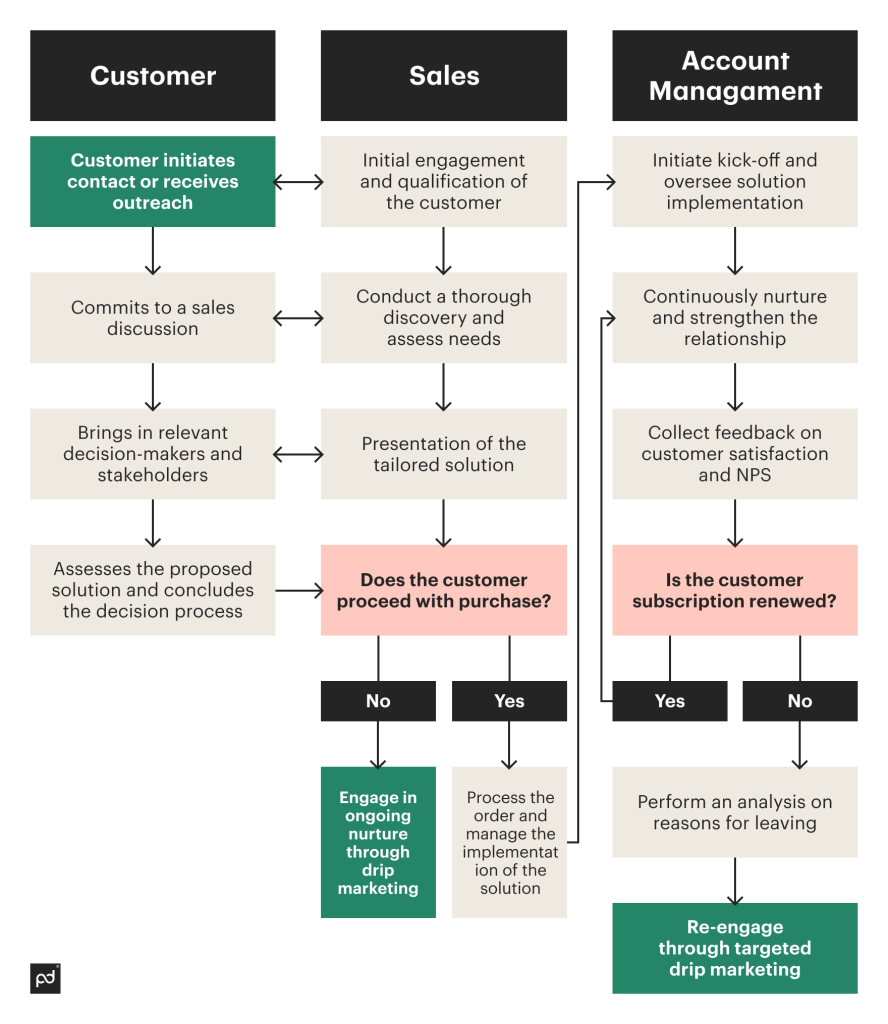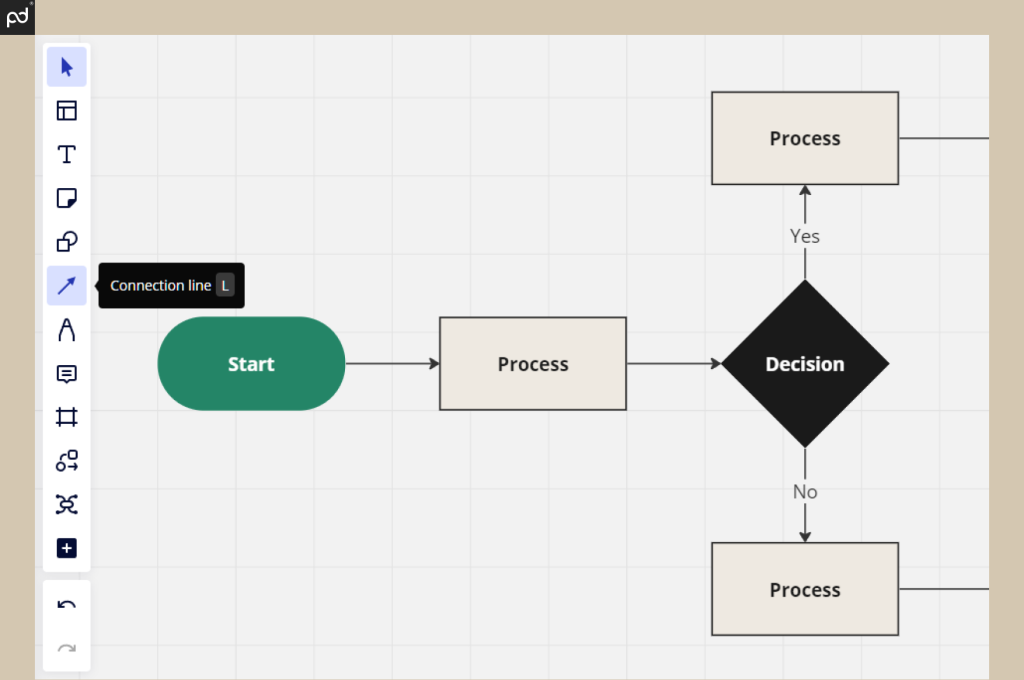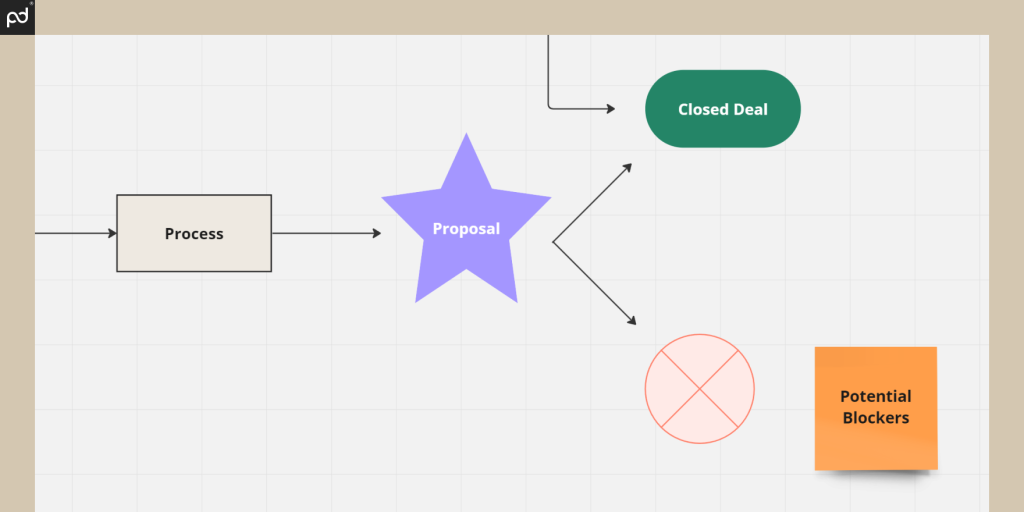Regardless of your destination, you’re better off using a map to reach it, right?
The same applies to sales.
The key goal of sales process mapping is to help your team accelerate performance by defining and then optimizing visualized steps to help them rack up more wins.
So, if you’re ready to move past relying on your gut feeling as a compass, gain more confidence in your sales processes, and start crushing targets and hitting desired outcomes, read on!
Below, we’ll cover exactly what a sales process map is and how you and your sales team can work together to create one.
Doing so provides a window into improving every step of the sales pipeline.
Key takeaways
- Sales process mapping visually displays the steps from prospect to customer, adding clarity, efficiency, and consistency in the sales process.
- There is no right or wrong sales mapping structure or naming, though it should always be results-based, easily understood and adopted by all team members.
- A well-defined sales process map involves key stakeholders, breaking down the stages and naming them accordingly, with various media employed to visualize the map, and tracking the progress through key sales metrics.
- Integrating CRM systems with a sales process map supports and enhances the sales workflow by enabling instant access to data, automating routine tasks, and ensuring alignment between sales activities.
What is sales process mapping
Think of a sales process mapping as drawing a visual representation of steps your team should take to convert a prospect into a customer.
The term “map” here is used as a generalization since it could be a flowchart or an infographic — the choice is always up to a team.
Regardless of how your sales process map will be visualized, it should clearly represent the buyer’s journey from the first contact to closing the deal.

Why does your team need a sales process map
Having a well-defined sales mapping process leads to a higher win rate and shorter sales cycles through:
- Clarity: Sales process mapping acts as a clear visual guide for all team members, illustrating all the steps involved in improving the sales process.
- Alignment: This map allows everyone on the team to understand their role and how it fits into the overall process and contributes to closing the deal.
- Efficiency: A sales process map streamlines and speeds up operations since it reduces confusion and redundancy.
- Sales performance measurement: A sales map enables easy document tracking and assessment of progress, issues faced, and performance.
- Onboarding: Structured steps and actions in a sales map enable smoother training and onboarding of new team members.
How to create a sales process map: our step-by-step guide
Here are the steps we recommend to map your sales process — but feel free to adapt and customize it to your specific business needs and sales goals:
Step 1: Engage key stakeholders
Creating a sales process map should involve cross-functional teams to ensure a clear understanding of the entire customer journey.
Including key stakeholders will help you identify issues and areas for improvement and gain diverse insights for a more customized and effective map.
Involve representatives from sales, marketing, customer success, and any other departments that may provide insight.
Step 2: Write down the current sales strategy
Gather input from the stakeholders to map the existing sales process.
This stage allows you to understand the sequence of actions, decision points, and interactions involved in moving buyer personas through the sales funnel.
Step 3: Break down and name the stages
Once you have a current sales strategy in front of you, the next step will be dividing the process into stages and giving them names respectively.
The list may look like:
- Prospecting
- Contact creation
- Discovery call
- Lead qualification
- Leads nurturing
- Proposal
- Quote
- Objections handling
- Sale closure
- Customer retention
Step 4: Clarify each stage’s details
The next step will be providing detailed descriptions for each stage.
These could be:
- Start and exit criteria — what should happen for a prospect to enter each stage of the sales funnel;
- Actions required — sending follow-up emails, conducting discovery calls, etc.;
- Decision points — helps guide the sales team on when to take certain actions or make critical decisions.
The details of each stage will also be different from team to team.
The key thing to keep in mind is that everyone on the entire sales team should understand the expectations and responsibilities associated with each stage.
Step 5: Create the map itself
Once the steps are identified and clarified, it is time to draw the map.
The first move here will be choosing a visualization tool.
We’re using Miro for the sales process mapping examples below; you can consider using Canva or other tools, or ask your in-house graphic designers to create a custom sales process map for your company.
Start drawing a sales process map by adding simple shapes or boxes to represent each stage of the current sales methodology.

Connect the stages using arrows or lines so they can indicate the flow of the sales process.
Arrows or lines should show the direction of progression from one stage to the next.

Use intuitive elements representing decision points (like diamonds) or blockers (like red blocks) and label them accordingly.

Leave some space for notes where you can specify details for each stage.
It is always best to keep the map as simple as possible so that all the details for each stage can also be located in a separate document linked to the map.
Step 6: Track and measure the process
This step helps estimate performance, identify optimization areas, and simplify forecasting and planning.
Evaluate progress across the following steps:
- Identify the key sales metrics: conversion rates, average deal size, opportunity win rate, quota attainment, and sales cycle length.
- Implement tracking mechanisms: use CRM software (more on that below) to gain insights on deal progression, durations of stages, and other relevant metrics you establish for your team.
- Review sales process metrics regularly: consider adding regular sales Zooms or performance reviews.
- Iterate and improve: use gained insights to make further adjustments when required.
How CRMs support a sales process map
Customer relationship management (CRM) systems localize all your client intel, which then sets the table for enhanced sales strategies.
Your sales process map is strengthened because a CRM:
Serves as a centralized repository for storing data
Integrating your CRM enables instant access to real-time information about where each deal stands in the sales pipeline.
Automates routine sales tasks and workflows
Combining your sales map and CRM will help automate routine tasks like sending follow-up emails, scheduling calls, and updating deal statuses.
Provides robust analytics and reporting features
CRMs are also effective in tracking key performance metrics (KPIs) better and analyzing sales trends over time.
Allows for customization
You can also customize your CRM so it perfectly aligns with the stages and managed workflows defined in the sales process map.
This helps in aiding consistency and smooth interaction between the two systems.
Sales process mapping best practices
- Provide training and resources for the sales team. Always make sure your team has the ability to learn — this may include ongoing training on service/product knowledge, sales techniques, objection handling guides, customer relationship management and/or fresh sales scripts.
- Regularly review and update the stages as needed. The sales process should remain dynamic and adaptive to market trends or changing business needs, so ensure the process always aligns with your goals.
- Leverage the power of automation and integration. This ties into our mention of CRMs above — leverage the use of document management and workflow automation tools to fast-track repetitive tasks, organize quick access to data, effectively track leads, customer interactions and automating email sequences for follow-ups.
Align all sales activities with PandaDoc
PandaDoc provides sales automation software designed to streamline all aspects of the sales process, such as document creation via our library of templates, to assisting with e-signatures and secure doc management and storage.
Harness the platform to optimize the link between your sales process map and your CRM, keeping all sales activities aligned while generating robust analytics throughout each stage of your team’s pipeline.
Ready to give it a try?
Disclaimer
PandaDoc is not a law firm, or a substitute for an attorney or law firm. This page is not intended to and does not provide legal advice. Should you have legal questions on the validity of e-signatures or digital signatures and the enforceability thereof, please consult with an attorney or law firm. Use of PandaDoc services are governed by our Terms of Use and Privacy Policy.


